
The Cuban Revolution was the military and political effort to overthrow Fulgencio Batista's dictatorship which reigned as the government of Cuba between 1952 and 1959. It began after the 1952 Cuban coup d'état which saw former president and military general, Fulgencio Batista topple the nascent Cuban democracy and consolidate power. Among those opposing the coup was Fidel Castro, then a novice attorney who attempted to contest the coup through Cuba's judiciary. Once these efforts proved fruitless, Fidel Castro and his brother Raúl launched armed attack on the Cuban military's Moncada Barracks on July 26, 1953. Following the attack's failure, Fidel Castro and his co-conspirators were detained and formed the 26th of July Movement (M-26-7). At his trial, Fidel Castro launched into a two hour speech that garnered him national fame as he laid out his grievances against the Batista dictatorship. In an attempt to win public approval, Batista authorized amnesty to the surviving Moncada Barracks attackers and forced them into exile. The Castro brothers regrouped abroad with Che Guevara whom they met in Mexico. In 1956 the rebels returned to Cuba upon the Gramna, a yacht whose landing was interrupted by fire from Batista's troops. Guevara and the Castro brothers fled into the Sierra Maestra where the M-26-7 rebel forces would reorganize, conducting urban sabotage and covert recruitment. Over time the originally critical and ambivalent Popular Socialist Party would see its influence and power wane towards the 26th of July Movement. As the movement against Batista escalated, the rebel forces transformed from crude, guerrilla fighters into a cohesive, fighting force that could confront Batista's army in military engagements. By the time the rebels were able to oust Batista, the revolution was being driven by a coalition between the Popular Socialist Party, 26th of July Movement, and the Revolutionary Directorate of March 13.
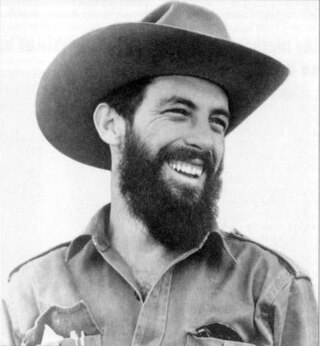
Camilo Cienfuegos Gorriarán was a Cuban revolutionary. One of the major figures of the Cuban Revolution, he was considered second only to Fidel Castro among the revolutionary leadership.
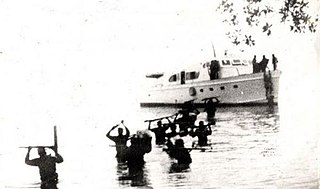
Granma is a yacht that was used to transport 82 fighters of the Cuban Revolution from Mexico to Cuba in November 1956 to overthrow the regime of Fulgencio Batista. The 60-foot diesel-powered vessel was built in 1943 by Wheeler Shipbuilding of Brooklyn, New York, as a light armored target practice boat, US Navy C-1994, and modified postwar to accommodate 12 people. "Granma", in English, is an affectionate term for a grandmother; the yacht is said to have been named for the previous owner's grandmother.

The 26th of July Movement was a Cuban vanguard revolutionary organization and later a political party led by Fidel Castro. The movement's name commemorates the failed 1953 attack on the Moncada Barracks in Santiago de Cuba, part of an attempt to overthrow the dictator Fulgencio Batista.

Arnaldo Tomás Ochoa Sánchez was a Cuban general who was executed by the government of Fidel Castro after being found guilty of a variety of crimes including drug smuggling and treason.
Operation Verano was the name given to the summer offensive in 1958 by the Batista government during the Cuban Revolution, known to the rebels as La Ofensiva. The offensive was designed to crush Fidel Castro's revolutionary army, which had been growing in strength in the area of the Sierra Maestra mountains since their arrival in Cuba on board the Granma yacht in December 1956. The offensive was met with resistance, notably at the Battle of La Plata and the Battle of Las Mercedes, and failed in its objective. The failure left the Cuban army dispirited and demoralized. Castro viewed it as a victory and soon launched his own offensive.

The Battle of Las Mercedes was the last battle which occurred during the course of Operation Verano, the summer offensive of 1958 launched by the Batista military dictatorship during the Cuban Revolution against the nationalist independence Cuban rebels of the 26th of July Movement.
Frank País García was a Cuban revolutionary who campaigned for the overthrow of General Fulgencio Batista's government in Cuba. País was the urban coordinator of the 26th of July Movement, and was a key organizer within the urban underground movement, collaborating with Fidel Castro's guerrilla forces which were conducting activities in the Sierra Maestra mountains. País was killed in the streets of Santiago de Cuba by the Santiago police on July 30, 1957.
Radio Rebelde is a Cuban Spanish-language radio station. It broadcasts 24 hours a day with a varied program of national and international music hits of the moment, news reports and live sport events. The station was set up in 1958 by Che Guevara in the Sierra Maestra region of eastern Cuba, and was designed to broadcast the aims of the 26th of July Movement led by Fidel Castro.
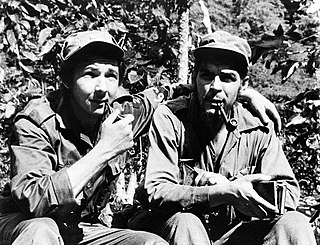
A guerilla foco is a small cadre of revolutionaries operating in a nation's countryside. This guerilla organization was popularized by Che Guevara in his book Guerilla Warfare, which was based on his experiences in the Cuban Revolution. Guevara would go on to argue that a foco was politically necessary for the success of a socialist revolution. Originally Guevara theorized that a foco was only useful in overthrowing personalistic military dictatorships and not liberal democratic capitalism where a peaceful overthrow was believed possible. Years later Guevara would revise his thesis and argue all nations in Latin America, including liberal democracies, could be overthrown by a guerilla foco. Eventually the foco thesis would be that political conditions would not even need to be ripe for revolutions to be successful, since the sheer existence of a guerilla foco would create ripe conditions by itself. Guevara's theory of foco, known as foquismo, was self-described as the application of Marxism-Leninism to Latin American conditions, and would later be further popularized by author Régis Debray. The proposed necessity of a guerilla foco proved influential in Latin America, but was also heavily criticized by other socialists.
The Cuban Revolution was the overthrow of Fulgencio Batista's regime by the 26th of July Movement and the establishment of a new Cuban government led by Fidel Castro in 1959.
The military history of Cuba is an aspect of the history of Cuba that spans several hundred years and encompasses the armed actions of Spanish Cuba while it was part of the Spanish Empire and the succeeding Cuban republics.
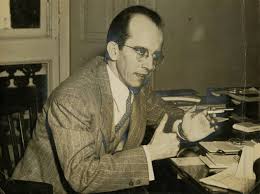
Felipe Pazos Roque was a Cuban economist who initially supported the Cuban Revolution of Fidel Castro, but became disillusioned with the increasingly radical nature of the revolutionary government. Born in Havana, Pazos earned a doctorate from the University of Havana in 1938. He was a member of the Cuban delegation to the 1944 Bretton Woods conference. In 1946, he joined the staff of the fledgling International Monetary Fund that had been established at the Bretton Woods conference. He worked there for three years before returning to Cuba in 1950 to head the newly established National Bank of Cuba for two years at the behest of Cuban President Carlos Prío Socarrás.
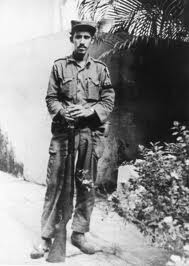
Efigenio Ameijeiras Delgado was a Cuban military commander affiliated with Fidel Castro from the 1950s. Son of Manuel Ameijeiras Fontelo, a native of Pontevedra (Spain) and the Cuban María de las Angustias Delgado Romo, from Corral Falso, in Matanzas. At the age of four, his father disappeared, so his mother had to take care of her children alone.
The Cuban communist revolutionary and politician Fidel Castro took part in the Cuban Revolution from 1953 to 1959. Following on from his early life, Castro decided to fight for the overthrow of Fulgencio Batista's military junta by founding a paramilitary organization, "The Movement". In July 1953, they launched a failed attack on the Moncada Barracks, during which many militants were killed and Castro was arrested. Placed on trial, he defended his actions and provided his famous "History Will Absolve Me" speech, before being sentenced to 15 years' imprisonment in the Model Prison on the Isla de Pinos. Renaming his group the "26th of July Movement" (MR-26-7), Castro was pardoned by Batista's government in May 1955, claiming they no longer considered him a political threat while offering to give him a place in the government, but he refused. Restructuring the MR-26-7, he fled to Mexico with his brother Raul Castro, where he met with Argentine Marxist-Leninist Che Guevara, and together they put together a small revolutionary force intent on overthrowing Batista.

Haydée Santamaría Cuadrado was a Cuban revolutionary and politician, regarded as a heroine in post-revolutionary Cuba. She participated in the assault on Moncada Barracks in Santiago de Cuba on July 26, 1953, an action for which she was imprisoned along with Melba Hernández. She was a founding member of the Central Committee of the Communist Party of Cuba and one of the first women to join the PCC. She maintained a high position in its leadership throughout her life. Having participated in the attack on the Moncada Barracks, Haydée Santamaría is among a relatively small group of people who were involved in every phase of the Cuban Revolution, from its inception to its fruition.
Delsa Esther Puebla Viltre, known by the nom de guerreTeté Puebla, is a Cuban politician and former guerilla fighter. She is the head of Cuba's Office of Veterans' Affairs and a member of Cuba's parliament, the National Assembly of People's Power, representing Havana. During the Cuban Revolution, Puebla fought as one of Fidel Castro's guerillas in the Sierra Maestra mountains as part of the Mariana Grajales Women's Platoon. In July 1996 she was promoted to brigadier general in the Cuban Revolutionary Armed Forces, becoming the first female general in the nation's history.

Uvero, also known as El Uvero, is a Cuban village and consejo popular of the municipality of Guamá, in Santiago de Cuba Province. In 2011 it had a population of 2,581.
Eduardo "Lalo" Sardiñas was a combatant of Cuban Revolution, and a member of the 26th of July Movement, led by Fidel Castro during 1958 and 1959.
Manuel Piti Fajardo Rivero was a Cuban revolutionary physician and fighter of the Rebel Army in the Sierra Maestra.










